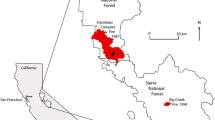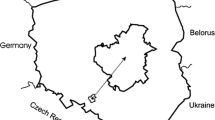Abstract
Forest buffer zones have recently been introduced in an attempt to suppress debris movement caused by mass wasting. There are, however, many questions left unsolved regarding the role of forests in suppressing debris movement and damage to forests by debris deposition. A number of debris avalanches occurred in southern Fukushima Prefecture and Hiroshima Prefecture in August 1998 and June 1999, respectively. Suppression of debris movement by forests and damage to forests by debris deposition were investigated in this study using aerial photographic interpretation and topographic analysis. Of the debris avalanches delineated in the Fukushima and Hiroshima areas, 282 and 84 sites, respectively, were forested, and 43 and seven sites, respectively, were nonforested. Topographic parameters, land use, and forest type at each site were surveyed by aerial photographic interpretation and topographic analysis. Suppression of debris movement by forest vegetation was confirmed by higher equivalent coefficients of friction and shorter average deposition zone length (about 28% and 55% shorter in the Fukushima and Hiroshima areas, respectively) in forested sites compared with nonforested sites. While previous studies suggested that the width of the forest zone required to prevent sediment outflow by surface erosion increases with increasing slope gradient, no clear relationship was found in this study. While the length of deposition zone of debris material (this study) is strongly affected by the dynamic solid friction coefficient and fluid friction of debris material, the length of deposition zone of the outflow of surface wash (past studies) is mainly affected by the tractive force of water flow. Among the 65 trees that remained at the terminus of deposition zones at five sites, 36 were alive and 29 were dead. Damage to the forest increases with increasing thickness of deposits and decreases with increasing tree diameter. Such results are useful for designing forest buffer zones.
Similar content being viewed by others
Author information
Authors and Affiliations
Additional information
Received: June 18, 2001 / Accepted: August 21, 2002
Correspondence to:Y. Ishikawa
About this article
Cite this article
Ishikawa, Y., Kawakami, S., Morimoto, C. et al. Suppression of debris movement by forests and damage to forests by debris deposition. J For Res 8, 0037–0047 (2003). https://doi.org/10.1007/s103100300004
Issue Date:
DOI: https://doi.org/10.1007/s103100300004




